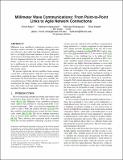| dc.contributor.author | Hassanieh, Haitham | |
| dc.contributor.author | Salehi-Abari, Omid | |
| dc.contributor.author | Rodriguez, Michael | |
| dc.contributor.author | Katabi, Dina | |
| dc.date.accessioned | 2017-12-01T23:09:40Z | |
| dc.date.available | 2017-12-01T23:09:40Z | |
| dc.date.issued | 2016-11 | |
| dc.identifier.isbn | 9781450346610 | |
| dc.identifier.uri | http://hdl.handle.net/1721.1/112351 | |
| dc.description.abstract | Millimeter wave (mmWave) technologies promise to revolutionize wireless networks by enabling multi-gigabit data rates. However, they suffer from high attenuation, and hence have to use highly directional antennas to focus their power on the receiver. Existing radios have to scan the space to find the best alignment between the transmitter’s and receiver’s beams, a process that takes up to a few seconds. This delay is problematic in a network setting where the base station needs to quickly switch between users and accommodate mobile clients.
We present Agile-Link, the first mmWave beam steering system that is demonstrated to find the correct beam alignment without scanning the space. Instead of scanning, Agile- Link hashes the beam directions using a few carefully chosen hash functions. It then identifies the correct alignment by tracking how the energy changes across different hash functions. Our results show that Agile-Link reduces beam steering delay by orders of magnitude. | en_US |
| dc.description.sponsorship | National Science Foundation (U.S.) | en_US |
| dc.language.iso | en_US | |
| dc.publisher | Association for Computing Machinery (ACM) | en_US |
| dc.relation.isversionof | http://dx.doi.org/10.1145/3005745.3005766 | en_US |
| dc.rights | Creative Commons Attribution-Noncommercial-Share Alike | en_US |
| dc.rights.uri | http://creativecommons.org/licenses/by-nc-sa/4.0/ | en_US |
| dc.source | MIT Web Domain | en_US |
| dc.title | Millimeter Wave Communications | en_US |
| dc.type | Article | en_US |
| dc.identifier.citation | Abari, Omid, Haitham Hassanieh, Michael Rodriguez, and Dina Katabi. “Millimeter Wave Communications.” Proceedings of the 15th ACM Workshop on Hot Topics in Networks - HotNets ’16 (2016). | en_US |
| dc.contributor.department | Massachusetts Institute of Technology. Computer Science and Artificial Intelligence Laboratory | en_US |
| dc.contributor.department | Massachusetts Institute of Technology. Department of Electrical Engineering and Computer Science | en_US |
| dc.contributor.mitauthor | Salehi-Abari, Omid | |
| dc.contributor.mitauthor | Rodriguez, Michael | |
| dc.contributor.mitauthor | Katabi, Dina | |
| dc.relation.journal | Proceedings of the 15th ACM Workshop on Hot Topics in Networks - HotNets '16 | en_US |
| dc.eprint.version | Author's final manuscript | en_US |
| dc.type.uri | http://purl.org/eprint/type/ConferencePaper | en_US |
| eprint.status | http://purl.org/eprint/status/NonPeerReviewed | en_US |
| dspace.orderedauthors | Abari, Omid; Hassanieh, Haitham; Rodriguez, Michael; Katabi, Dina | en_US |
| dspace.embargo.terms | N | en_US |
| dc.identifier.orcid | https://orcid.org/0000-0001-8218-6301 | |
| dc.identifier.orcid | https://orcid.org/0000-0002-4206-6783 | |
| dc.identifier.orcid | https://orcid.org/0000-0003-4854-4157 | |
| mit.license | OPEN_ACCESS_POLICY | en_US |
| mit.metadata.status | Complete | |
